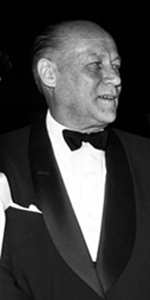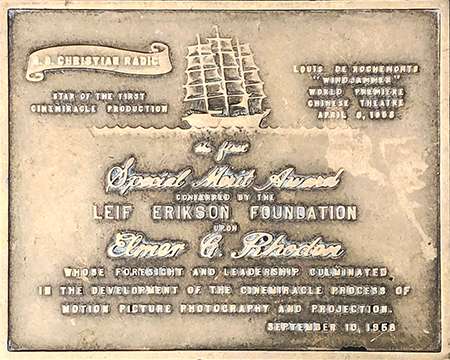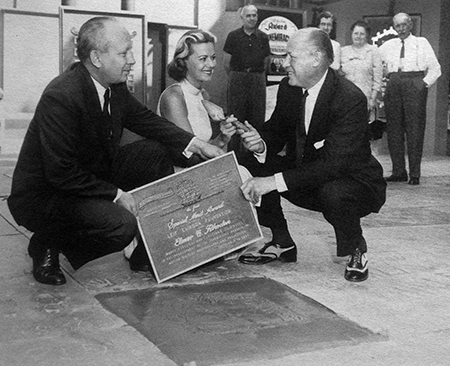 |
 |
 |
 |
 |
| Elmer C. Rhoden (as preseident of National Theatres) attended the World premiere of Rhoden's brainchild,Windjammer, Held at the Chinese, Tuesday, April 8, 1958. |
| |
|
 |
|
 |
| |
| |
|
|
| Elmer C. Rhoden/Windjammer Plaque
|
 |
Ceremony held on Tuesday, September 16, 1958
|
| |
Now and again, someone suggests an idea to the Chinese Theatre regarding the Forecourt, and to celebrate the fifth month of the engagement of Windjammer at the theatre, the Los Angeles-based Leif Erikson Foundation paid tribute to both the film and the man who allowed it to be realized: National Theatres president Elmer C. Rhoden.
The Leif Erikson
Foundation had been formed in 1956 by Foundation president Dr. Vaino A. Hoover (an areospace engineer by profession) to honor the pioneering spirit of the Scandanavian explorer, and to recognize that pioneering spirit in others. Occasionally, the Foundation would present an award of some kind to an individual who they felt embodied the adventuresome spirit of Leif Erikson.
Elmer C. Rhoden was born in Kansas City Kansas in 1893. After graduating from Nebraska University in 1912, Rhoden became a salesman for the General Film Company in their Omaha branch. After fighting in World War I, Rhoden returned to his hometown of Kansas City, where he became the branch manager for First National Pictures, a film production company formed in 1917, which was owned by independent theatre owners across the country. Before long, Rhoden had become very well-known in Kansas City for his civic spirit.
With his connections in the movie theatre world, Rhoden began to buy theatres in the midwest, eventually selling his interest in them to Fox Theatres. Rhoden rose through the ranks of executives during the merging of the Fox chain to the West Coast chain, which in turn was called Fox West Coast Theatres. Grauman's Chinese was sold to FCWT in June 1929. When FWCT went into bankrupcy in 1933, it was bought by National Theatres, led by St. Louis-based exhibitor Charles Skouras (1889-1954, and brother of Spyros Skouras [1893-1971], who would become president of 20th Century-Fox in 1942).
When Charles Skouras retired in 1952, he promoted his right-hand man Rhoden to the presidency. Rhoden felt that the way to survive the marketplace then greatly reduced by television was through diversification — he sought to buy television stations and to develop amusement parks. But most importantly, to fulfill Charles Skouras's desire to have his own widescreen format (brother Spyros had CinemeScope) and to produce films in the new format.
Cut to: Louis De Rochemont, creator of The March of Time newsreels (which played the Chinese from the beginning in February 1935). De Rochemont had been working on the second Cinerama film, Cinerama Holiday when he discovered two things: first, that Cinerama was a money pit, and second, Cinerama had hired the Smith-Deitrich company to help with the annoying "join lines" in the three-camera system. Cinerama had neglected to pay monies due to the Smith-Deitrich company, so De Rochemont took the whole thing, plus an idea for a movie he and his son (Norwegian lovers, both) were working on about a Norwegian Naval training vessel to Rhoden, who immediately said "Yes."
Rhoden had his chief FWCT technical director, Russel H. McCullough, develop something which could be a portable version of Cinerama. They called it Cinemiracle. Cameras and projectors were built, and Rhoden obtained limited permission from the US Justice Department to re-enter forbidden territory by owning all three parts of the movie business puzzle: production, distribution, and exhibition.
With the elder De Rochemont producing and with his son directing, the film
Windjammer (which World Premiered at the Chinese on April 8, 1958) was not an easy film to make. Meanwhile at the Chinese, extensive alterations were embarked on, such as removing the stage and lowering the auditorium floor to accommodate a huge new screen. Windjammer certainly was a wow, still fondly remembered today.
But the ability to move the screening aparatus from place to place never really happened. Despite Windjammer's success, Rhoden couldn't get any of the Hollywood studios to co-produce any films in the system. With Rhoden's retirement in 1959, National Theatres put the whole shebang to bed; they sold the Cinemiracle patents, cameras and the rights to Windjammer to Cinerama.
Rhoden had established the Elmer C. Rhoden Charitable Trust sometime in the late 1940s to award scholarships for students attending his alma mater, the University of Nebraska. His son, Elmer C. Rhoden, produced a handful of teenage hot-rod movies: Corn's-A-Poppin (released in 1955) with Jerry Wallace (and co-written by Robert Altman!), Altman's feature film debut, The Delinquents (released in March 1957) with Tom Laughlin, The Cool and the Crazy (released in March 1958) with Scott Marlow, and Daddy-O (released in March 1958) with Dick Contino.
Elmer C. Rhoden died on July 14, 1981, in Kansas City Missouri, at the age of 88. His charitable trust has been inactive for a number of years. graumanschinese.org has attempted to find living relatives of Mr. Rhoden without success. The Leif Erirkson Foundation is no longer functioning, although there is an outfit in Seattle Washington which uses this name today.
Windjammer, thought to exsist only in 35mm 'Scope, has undergone a new restoration, due to the discovery of the original 3-panel camera negavtives. It has been released in a new Blu-ray, "Smileboxed" to replicate the curved screen experience of the original theatrical engagements.
|
|
|
|
|
| |
 |
 |
| Grauman's Chinese Theatre, Hollywood, California. Elmer C. Rhoden / Windjammer Forecourt plaque. Executed by John Tartaglia, Tuesday, September 16, 1958. 20 x 16 inches. |
|
 |
 |
 |
| Grauman's Chinese Theatre, Hollywood, California. Elmer C. Rhoden / Windjammer Ceremony, Tuesday, September 16, 1958. Leif Erikson Foundation president Dr. Vaino A. Hoover and actress Karen von Unge present National Theatres president Elmer C. Rhoden with a cement spade to embed the honorary plaque into the cement. Amazingly, it is still in the Forecourt today. |
|